You have an Azure DevOps project that uses many package feeds.
You need to simplify the project by using a single feed that stores packages produced by your company and packages consumed from remote feeds. The solution must support public feeds and authenticated feeds.
What should you enable in DevOps?
Answer:
B
Upstream sources enable you to use a single feed to store both the packages you produce and the packages you consume from "remote feeds". This includes both public feeds, such as npmjs.com and nuget.org, and authenticated feeds, such as other Azure DevOps feeds in your organization. Once you've enabled an upstream source, any user connected to your feed can install a package from the remote feed, and your feed will save a copy.
Reference:
https://azure.microsoft.com/en-us/blog/deep-dive-into-azure-artifacts/
DRAG DROP -
Your company has two virtual machines that run Linux in a third-party public cloud.
You plan to use the company's Azure Automation State Configuration implementation to manage the two virtual machines and detect configuration drift.
You need to onboard the Linux virtual machines.
You install PowerShell Desired State Configuration (DSC) on the virtual machines, and then run register.py.
Which three actions should you perform next in sequence? To answer, move the actions from the list of actions to the answer area and arrange them in the correct order.
Select and Place: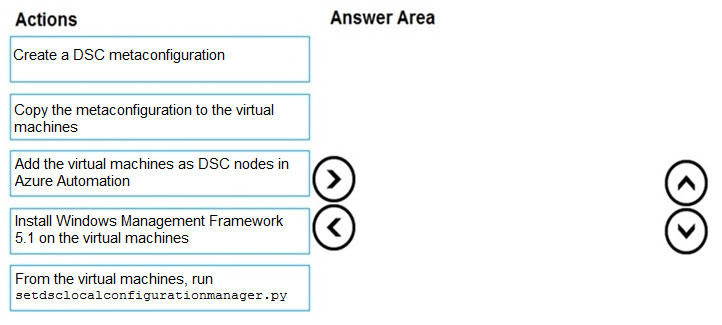
Answer:

Step 1: Create a DSC metaconfiguration
Load up the DSC Configuration into Azure Automation.
Step 2: Copy the metaconfiguration to the virtual machines.
Linking the Node Configuration to the Linux Host
Step 3: Add the virtual machines as DSC nodes in Azure Automation. go to DSC Nodes, select your node, and then click Assign node configuration. This step assigns the DSC configuration to the Linux machine.
Next up will be to link the node configuration to the host. Go to the host and press the ג€Assign nodeג€¦ג€-button. Next up you can select your node configuration.
SIMULATION -
You plan to deploy a runbook that will create Azure AD user accounts.
You need to ensure that runbooks can run the Azure PowerShell cmdlets for Azure Active Directory.
To complete this task, sign in to the Microsoft Azure portal.
Answer:
See explanation below.
Azure Automation now ships with the Azure PowerShell module of version 0.8.6, which introduced the ability to non-interactively authenticate to Azure using OrgId
(Azure Active Directory user) credential-based authentication. Using the steps below, you can set up Azure Automation to talk to Azure using this authentication type.
Step 1: Find the Azure Active Directory associated with the Azure subscription to manage:
1. Log in to the Azure portal as the service administrator for the Azure subscription you want to manage using Azure Automation. You can find this user by logging in to the Azure portal as any user with access to this Azure subscription, then clicking Settings, then Administrators.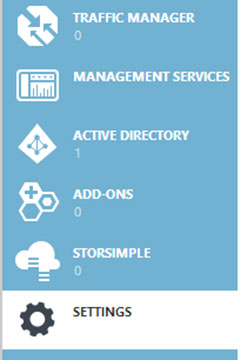
2. Note the name of the directory associated with the Azure subscription you want to manage. You can find this directory by clicking Settings, then Subscriptions.
Step 2: Create an Azure Active Directory user in the directory associated with the Azure subscription to manage:
You can skip this step if you already have an Azure Active Directory user in this directory. and plan to use this OrgId to manage Azure.
1. In the Azure portal click on Active Directory service.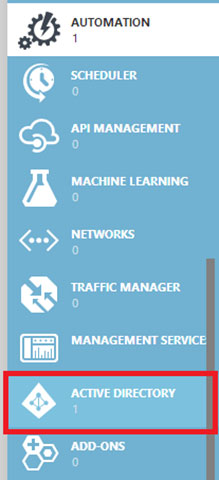
2. Click the directory name that is associated with this Azure subscription.
3. Click on the Users tab and then click the Add User button.
4. For type of user, select ג€New user in your organization.ג€ Enter a username for the user to create.
5. Fill out the user's profile. For role, pick ג€User.ג€ Don't enable multi-factor authentication. Multi-factor accounts cannot be used with Azure Automation.
6. Click Create.
7. Jot down the full username (including part after @ symbol) and temporary password.
Step 3: Allow this Azure Active Directory user to manage this Azure subscription.
1. Click on Settings (bottom Azure tab under StorSimple)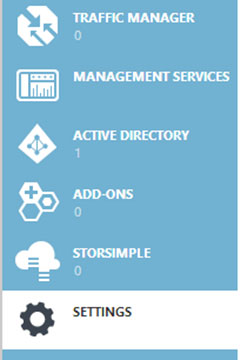
2. Click Administrators
3. Click the Add button. Type the full user name (including part after @ symbol) of the Azure Active Directory user you want to set up to manage Azure. For subscriptions, choose the Azure subscriptions you want this user to be able to manage. Click the check mark.
Step 4: Configure Azure Automation to use this Azure Active Directory user to manage this Azure subscription
Create an Azure Automation credential asset containing the username and password of the Azure Active Directory user that you have just created. You can create a credential asset in Azure Automation by clicking into an Automation Account and then clicking the Assets tab, then the Add Setting button.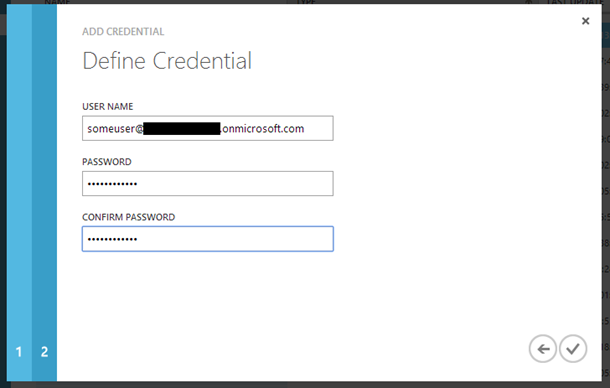
Note: Once you have set up the Azure Active Directory credential in Azure and Azure Automation, you can now manage Azure from Azure Automation runbooks using this credential.
Reference:
https://azure.microsoft.com/sv-se/blog/azure-automation-authenticating-to-azure-using-azure-active-directory/
DRAG DROP -
You are creating a container for an ASP.NET Core app.
You need to create a Dockerfile file to build the image. The solution must ensure that the size of the image is minimized.
How should you configure the file? To answer, drag the appropriate values to the correct targets. Each value may be used once, more than once, or not at all. You may need to drag the split bar between panes or scroll to view content.
NOTE: Each correct selection is worth one point.
Select and Place: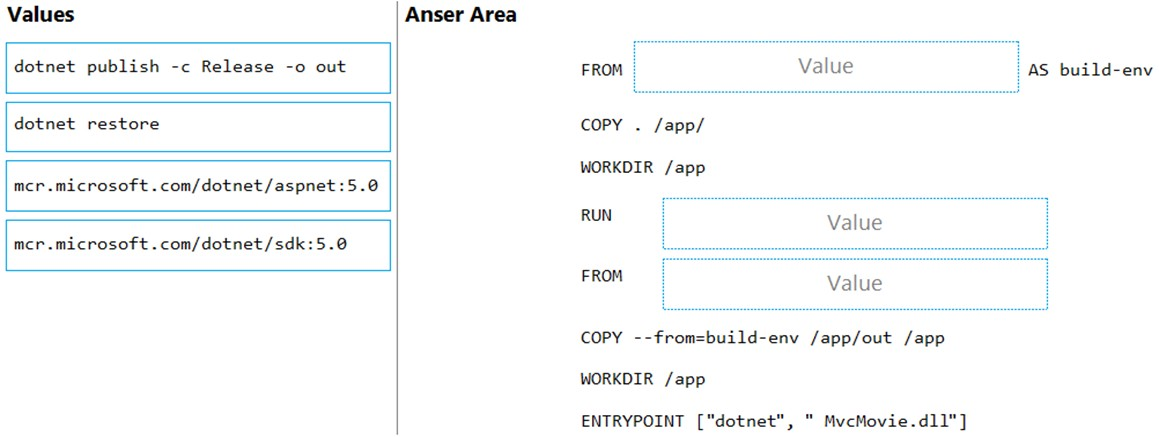
Answer:

Box 1: mcr.microsoft.com/dotnet/sdk:5.0
The first group of lines declares from which base image we will use to build our container on top of. If the local system does not have this image already, then docker will automatically try and fetch it. The mcr.microsoft.com/dotnet/core/sdk:5.0 comes packaged with the .NET core 5.0 SDK installed, so it's up to the task of building ASP .NET core projects targeting version 5.0
Box 2: dotnet restore -
The next instruction changes the working directory in our container to be /app, so all commands following this one execute under this context.
COPY *.csproj ./
RUN dotnet restore -
Box 3: mcr.microsoft.com/dotnet/aspnet:5.0
When building container images, it's good practice to include only the production payload and its dependencies in the container image. We don't want the .NET core SDK included in our final image because we only need the .NET core runtime, so the dockerfile is written to use a temporary container that is packaged with the SDK called build-env to build the app.
Reference:
https://docs.microsoft.com/en-us/virtualization/windowscontainers/quick-start/building-sample-app
DRAG DROP -
You are configuring the settings of a new Git repository in Azure Repos.
You need to ensure that pull requests in a branch meet the following criteria before they are merged:
✑ Committed code must compile successfully.
✑ Pull requests must have a Quality Gate status of Passed in SonarCloud.
Which policy type should you configure for each requirement? To answer, drag the appropriate policy types to the correct requirements. Each policy type may be used once, more than once, or not at all. You may need to drag the split bar between panes or scroll to view content.
NOTE: Each correct selection is worth one point.
Select and Place:
Answer:

Box 1: A check-in policy -
Administrators of Team Foundation version control can add check-in policy requirements. These check-in policies require the user to take actions when they conduct a check-in to source control.
By default, the following check-in policy types are available:
✑ Builds Requires that the last build was successful before a check-in.
✑ Code Analysis Requires that code analysis is run before check-in.
✑ Work Items Requires that one or more work items be associated with the check-in.
Box 2: Build policy -
Reference:
https://docs.microsoft.com/en-us/azure/devops/repos/tfvc/add-check-policies https://azuredevopslabs.com/labs/vstsextend/sonarcloud/
You use a Git repository in Azure Repos to manage the source code of a web application. Developers commit changes directly to the default branch.
You need to implement a change management procedure that meets the following requirements:
✑ The default branch must be protected, and new changes must be built in the feature branches first.
✑ Changes must be reviewed and approved by at least one release manager before each merge.
✑ Changes must be brought into the default branch by using pull requests.
What should you configure in Azure Repos?
Answer:
A
Branch policies help teams protect their important branches of development. Policies enforce your team's code quality and change management standards.
Reference:
https://docs.microsoft.com/en-us/azure/devops/repos/git/branch-policies
Note: This question is part of a series of questions that present the same scenario. Each question in the series contains a unique solution that might meet the stated goals. Some question sets might have more than one correct solution, while others might not have a correct solution.
After you answer a question in this section, you will NOT be able to return to it. As a result, these questions will not appear in the review screen.
Your company uses Azure DevOps to manage the build and release processes for applications.
You use a Git repository for applications source control.
You need to implement a pull request strategy that reduces the history volume in the master branch.
Solution: You implement a pull request strategy that uses fast-forward merges.
Does this meet the goal?
Answer:
A
No fast-forward merge - This option merges the commit history of the source branch when the pull request closes and creates a merge commit in the target branch.
Reference:
https://docs.microsoft.com/en-us/azure/devops/repos/git/branch-policies
Note: This question is part of a series of questions that present the same scenario. Each question in the series contains a unique solution that might meet the stated goals. Some question sets might have more than one correct solution, while others might not have a correct solution.
After you answer a question in this section, you will NOT be able to return to it. As a result, these questions will not appear in the review screen.
Your company uses Azure DevOps to manage the build and release processes for applications.
You use a Git repository for applications source control.
You need to implement a pull request strategy that reduces the history volume in the master branch.
Solution: You implement a pull request strategy that uses squash merges.
Does this meet the goal?
Answer:
B
Instead use fast-forward merge.
Note:
Squash merge - Complete all pull requests with a squash merge, creating a single commit in the target branch with the changes from the source branch.
No fast-forward merge - This option merges the commit history of the source branch when the pull request closes and creates a merge commit in the target branch.
Reference:
https://docs.microsoft.com/en-us/azure/devops/repos/git/branch-policies
Note: This question is part of a series of questions that present the same scenario. Each question in the series contains a unique solution that might meet the stated goals. Some question sets might have more than one correct solution, while others might not have a correct solution.
After you answer a question in this section, you will NOT be able to return to it. As a result, these questions will not appear in the review screen.
Your company uses Azure DevOps to manage the build and release processes for applications.
You use a Git repository for applications source control.
You need to implement a pull request strategy that reduces the history volume in the master branch.
Solution: You implement a pull request strategy that uses an explicit merge.
Does this meet the goal?
Answer:
B
Instead use fast-forward merge.
Note:
No fast-forward merge - This option merges the commit history of the source branch when the pull request closes and creates a merge commit in the target branch.
Reference:
https://docs.microsoft.com/en-us/azure/devops/repos/git/branch-policies
Note: This question is part of a series of questions that present the same scenario. Each question in the series contains a unique solution that might meet the stated goals. Some question sets might have more than one correct solution, while others might not have a correct solution.
After you answer a question in this section, you will NOT be able to return to it. As a result, these questions will not appear in the review screen.
Your company uses Azure DevOps to manage the build and release processes for applications.
You use a Git repository for applications source control.
You need to implement a pull request strategy that reduces the history volume in the master branch.
Solution: You implement a pull request strategy that uses a three-way merge.
Does this meet the goal?
Answer:
B
Instead use fast-forward merge.
Note:
No fast-forward merge - This option merges the commit history of the source branch when the pull request closes and creates a merge commit in the target branch.
Reference:
https://docs.microsoft.com/en-us/azure/devops/repos/git/branch-policies